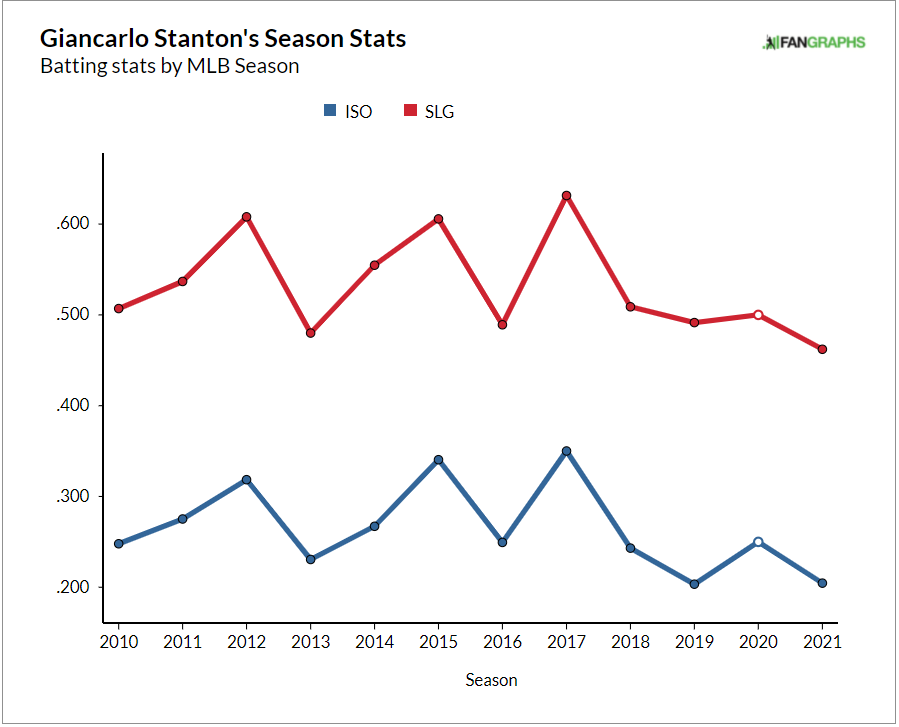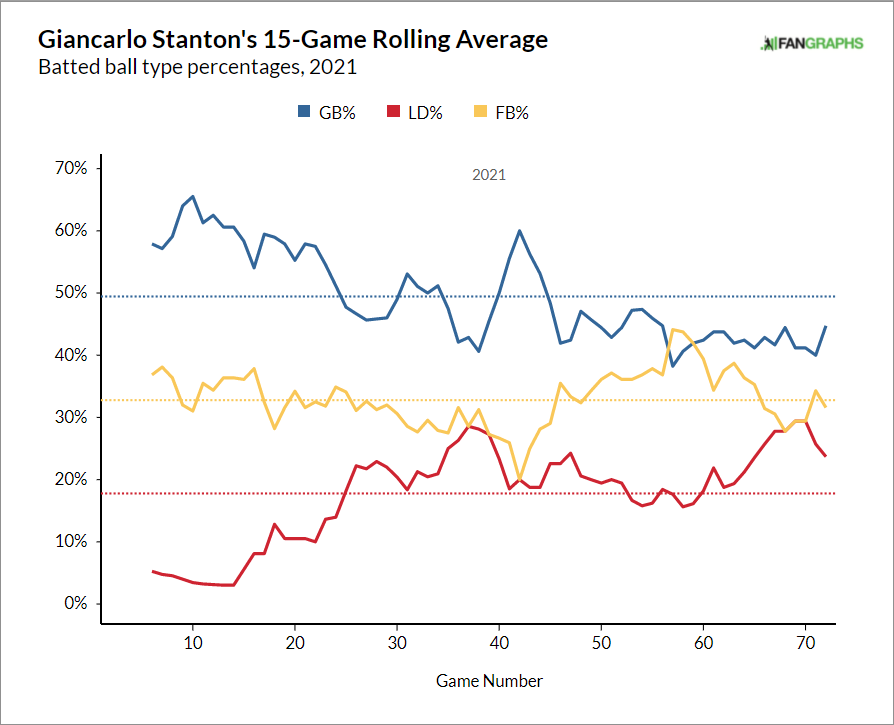Although you wouldn’t know it by the loud complaints of Yankee fans, Giancarlo Stanton actually had a pretty great first half. Through his 303 plate appearances, he’s hitting .258/.350/.462 with 15 home runs, good for a 124 wRC+. Objectively, Stanton has been above-average at creating runs for the Yankees, but not to the elite degree he typically does. But nonetheless Stanton has been able to remain mostly healthy, which is undoubtedly the most important thing for someone with his offensive ceiling. And if all Stanton did in the second half was repeat the same level of production, that would be just fine, but, I think he might be due for a positive regression. The single piece that has been missing the most from Stanton’s offense is ironically what he’s most known for—his power. Stanton’s overall production has wavered up and down throughout his 11-season career, but for the most part his power has always shown up consistently. This season he’s posting a career low slugging, by nearly 20 points, and a career low ISO, by over 25 points (if you don’t count his 2019 where he only logged 72 PA). Over his career it’s a big outlier, especially when just looking at his healthy seasons. Here’s how the season stacks up.

This might cause for some concern, since the trend’s direction is not exactly inspiring, but I don’t think there should be any concern over Stanton’s power numbers. First, it’s important to note that he missed the majority of his last two seasons, logging just 166 PA over that span, but there also aren’t many other signs of diminishing power. His 58.3% hard hit rate is a StatCast-era career high, his average exit velocity is just about tied with his career high from 2015, and his max exit velocity is right in line with the rest of his seasons. And relative to the rest of the league, he’s the league leader in all three metrics! If you weren’t already aware, hitting the ball hard is really important for producing power. It’s probably the single-component metric that holds the strongest correlation to home runs and extra base hits. We know this from lots of research and data. But for simple proof, just take a look at the league’s top sluggers this season, with Stanton thrown in the mix.
Of course, more goes into home runs than only hitting the ball hard, but it’s a solid indicator of raw power and assuming Stanton’s raw strength hasn’t gone anywhere is one of the safer assumptions in baseball. However, it’s trivial that the power potential Stanton possesses isn’t nearly as important as actually hitting for power in games. And like I said earlier, that’s probably what he will need to do if he wants to have a huge second half.
So what other factors are contributing to Stanton’s lack of power? Well, the whiffing and strikeouts certainly don’t help. But Stanton has always been one of the worst hitters in the league in swings and misses and strikeouts. It’s nothing new, and it isn’t really a make or break kind of thing for Stanton, so there’s no real point in analyzing it. It’s just part of him as a hitter and that’s fine! But what Stanton really needs to do is start elevating the ball way, way, more often. Fly balls or line drives—it doesn’t really matter! Stanton just needs to stop hitting the ball on the ground as often as he is.
As of today, Stanton is seeing a career high in ground ball rate, a career low in line drive rate, and one of his lowest fly ball rates among his career. That’s pretty troubling for someone who is expected to put up big power numbers, but there are some signs of life recently. When compared to the start of the season, Stanton is trending in the right direction.

The percentages are still wavering a bit, but over his last 10 games we can see Stanton beginning to hit more line drives, while that ground ball rate slowly falls. His fly ball rate hasn’t really changed much overall, but we can certainly see two positive trends over the course of the season for his ground ball and line drive rates. It’s about as simple as it gets. Stanton needs to keep the direction he’s going with his batted balls and continue to avoid ground balls if he wants to see better results. Why do I believe this? Other than the obvious—a hitter won’t find home runs from ground balls—a quick look at how Stanton is faring against pitch types might show a common theme. Stanton is mainly getting beat by offspeed and breaking pitches, where he is a hitting a grounder 17.6% and 37.4% of the time, respectively. His ground ball rate against offspeed pitches is the second highest of his career and his rate against breaking balls is the third highest of his career. On the bright side, Stanton’s ground ball rate against fastballs is his second lowest rate ever, resulting in a .427 wOBA against the pitch type. As for the other two pitch types, he’s seeing a .295 wOBA against breakers and .229 wOBA against offspeed pitches, some of the worst numbers in his career. Ground balls will do that.
The necessary changes don’t seem that far off for Stanton. His HR/FB rate of 25.4% falls right in line with his career and is by no means is an outlier, so it’s clear that when he does hit the ball in the air (specifically a fly ball in this case) Stanton still reaps the same benefit he has in years past. As aforementioned, if Stanton doesn’t make any changes he will still be an above-average hitter. That’s cool! And although the rolling average isn’t an overwhelming amount of evidence, I remain optimistic that Stanton’s hard hitting and batted ball trends set him up for a big second half. Getting off the ground will be the key if Stanton wants to take flight.
Photo by Brian Rothmuller/Icon Sportswire

